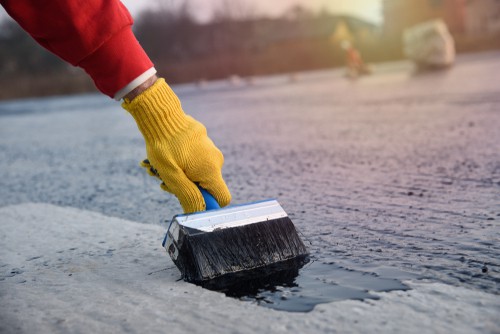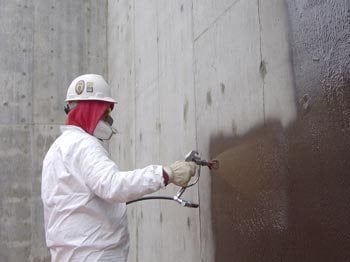Kinds of Waterproofing: Checking Out the Numerous Techniques and Their Applications
Waterproofing is a crucial facet of building and upkeep. It safeguards frameworks from the detrimental results of water damages. There are a number of approaches available, each with its unique applications and benefits. From membrane systems to cementitious options, recognizing these choices is vital for efficient execution. The choice of waterproofing method can greatly affect toughness and long life. Discovering these various techniques reveals their unique benefits and possible difficulties, motivating further consideration of excellent options.
Membrane Layer Waterproofing Solutions
Membrane waterproofing systems act as a crucial obstacle against water breach in numerous structures. These systems normally contain slim sheets made from materials like rubber, polycarbonate, or asphalt, which are put on surface areas to stop wetness infiltration. They can be set up above or listed below quality and are especially reliable in locations prone to high water direct exposure, such as cellars, roofing systems, and foundations.The setup procedure includes cleaning up the substrate, applying adhesives or guides, and specifically suitable the membrane layer to ensure full insurance coverage. Membrane systems can be either completely adhered, mechanically connected, or laid loose, depending upon the certain needs of the job. They provide longevity and flexibility, suiting architectural movements without endangering their waterproofing capabilities. Furthermore, these systems can be reinforced with additional layers for improved protection. Eventually, membrane layer waterproofing systems are crucial for protecting structures versus water damage and keeping lasting stability.
Liquid-Applied Waterproofing Coatings
Liquid-applied waterproofing coverings supply a versatile solution for securing surfaces from water infiltration - Yard drainage Omaha. These coatings include fluid materials that, when used, create a smooth, adaptable membrane layer. Their adaptability enables application on different substratums, consisting of concrete, steel, and timber. The layers can be utilized in varied atmospheres, from domestic to commercial settings, making them ideal for roofs, structures, and below-grade structures.One considerable advantage of liquid-applied layers is their capacity to comply with uneven shapes and penetrate splits, creating a durable barrier versus moisture. They often display superb adhesion homes and resistance to UV radiation, guaranteeing durability and sturdiness. Furthermore, the application process is generally uncomplicated, permitting for fast installation and minimized labor prices. This approach also minimizes the risk of water merging, as the continuous layer efficiently routes water far from susceptible areas. In general, liquid-applied waterproofing finishings are an efficient option for thorough water defense
Cementitious Waterproofing Solutions

Cementitious waterproofing options provide a durable choice for structures requiring reliable moisture protection. These systems largely make use of a blend of cement, sand, and chemical ingredients to produce a waterproof barrier. They are often used to surfaces such as concrete walls, foundations, and floorings, giving a resilient, long-lasting protection against water intrusion.One of the vital benefits of cementitious waterproofing is its ease of application; it can be applied making use of a brush, roller, or spray, making it suitable for different job dimensions. Furthermore, this method works with many surfaces and can often be utilized along with other waterproofing techniques.Cementitious solutions are specifically efficient in settings where water exposure is a concern, such as basements or below-grade frameworks. Their exceptional adhesion properties more guarantee that they bond well with substratums, supplying a strong and impenetrable layer versus dampness infiltration.
Bentonite Waterproofing
Bentonite waterproofing is a very efficient approach that utilizes salt bentonite clay to create an all-natural barrier versus water. This method makes use of the one-of-a-kind buildings of bentonite, which broadens upon contact with water, securing any kind of possible leakages and avoiding dampness infiltration. It is typically used in different applications, including structure wall surfaces, tunnels, and preserving wall surfaces, where water resistance is essential.Bentonite can be applied in numerous kinds, such as panels or blankets, giving flexibility in installation. Its ability to self-seal makes it an appealing choice for areas subject to shifting soil or ever-changing water degrees. Furthermore, bentonite waterproofing is eco-friendly, as it is a natural product that does not present hazardous chemicals into the environments.
Water Drainage and Exterior Waterproofing Equipments
Efficient waterproofing commonly involves a combination of strategies, including drainage and external systems. Drainage systems, such as French drains pipes and sump pumps, are made to reroute water away from frameworks, lowering hydrostatic pressure against foundations. These systems are necessary in protecting against water build-up that can cause structural damages and mold growth.External waterproofing, on the various other hand, includes using safety obstacles to the structure's outside. Techniques such as the setup of waterproof membrane layers, layers, or sealers can help protect against water infiltration. This technique not just secures the structure however likewise boosts the general resilience of the structure.Together, water drainage and outside waterproofing systems develop an extensive option to handle water successfully. By carrying out these methods, residential property proprietors can protect their investments versus the destructive impacts of dampness, making certain long-term stability and safety and security for their buildings.
Often Asked Concerns
How Do I Select the Right Waterproofing Technique for My Job?
Picking the ideal waterproofing technique relies on elements such as project type, environmental problems, budget, and wanted durability. Assessing these elements allows for informed click choices customized to details requirements and requirements.

Can Waterproofing Be Applied in Cold Weather Condition Issues?
Waterproofing can be applied in cool weather conditions, however it requires details materials and strategies. Cold temperatures may impact healing times and attachment, demanding careful choice of items designed for low-temperature application.
What Are the Common Indicators of Waterproofing Failure?
Usual indicators of waterproofing failing consist of visible water stains, peeling paint, moist odors, mold development, and cracks in wall surfaces or foundations. Basement waterproofing Omaha. These indications recommend that dampness is permeating the barrier, endangering its performance
How Much Time Does Waterproofing Last Prior To Needing Upkeep?
The long life of waterproofing varies, usually lasting in between 5 to ten years. Variables such as worldly top quality, environmental conditions, and upkeep practices influence its durability, demanding regular assessments to guarantee effective protection versus water intrusion.
Are There Eco-Friendly Waterproofing Options Available?
The inquiry of environment-friendly waterproofing options discloses a growing passion in sustainable materials (Water Solutions). Numerous all-natural compounds, such as plant-based sealants and recycled products, use efficient seal waterproof services while decreasing ecological impact, interesting environmentally aware consumers